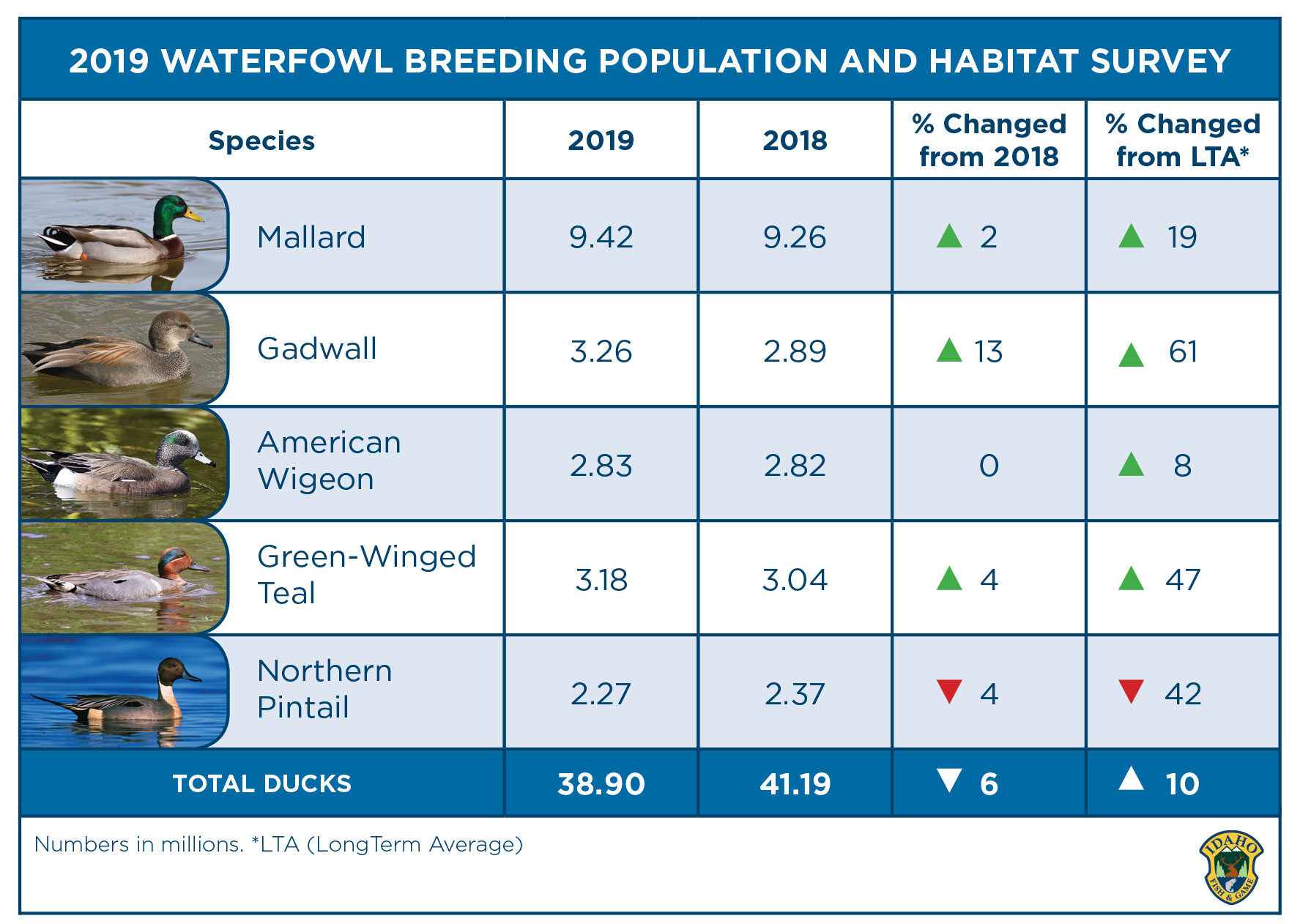Most waterfowl seasons in Idaho open on either Oct. 5 or Oct. 12, and the statewide youth hunt is Sept. 28-29. While hunting success will ultimately be determined by myriad local conditions during the 2019-20 season, this year’s North American Waterfowl Breeding and Population Habitat Survey offers hunters a glimpse of what the fall migration and hunting seasons might look like. Here is a look at the numbers:
The Big Picture
The U.S. Fish and Wildlife Service’s continent-wide waterfowl survey showed that habitat conditions in 2019 were similar to or declined compared with 2018, with a few exceptions. In the traditional survey areas across North America, the total duck population estimate was 38.9 million birds, which is 6 percent lower than the 2018 estimate of 41.2 million, but 10 percent higher than the long-term average from 1955 to 2018. With the exception of northern pintail and scaup, breeding population estimates for the ten most common duck species are at or above long-term averages.
Breakdown by species across North America

Estimated mallard abundance was 9.4 million, which was similar to 2018 estimate of 9.3 million, and 19 percent above the long-term average of 7.9 million. Estimated abundance of gadwall was 3.3 million, which was similar to the 2018 estimate and 61 percent above the long-term average. Estimated abundance of green-winged teal was 3.2 million, which was similar to the 2018 estimate of 3 million and 47 percent above the long-term average. Estimated abundance of northern pintail was 2.3 million, similar to the 2018 estimate and 42 percent below the long-term average of 2.9 million. Estimated abundance of American wigeon was 2.8 million, similar to 2018 and 8 percent above the long-term average.
The top-five most harvested ducks in Idaho include mallards, American wigeon, American green-winged teal, gadwall, and common goldeneye. Idaho hunters harvest more Canada geese and common goldeneyes than any other state in the Pacific Flyway.
Regional report
The federal harvest information program estimates that, on average, about 21,500 waterfowl hunters harvest over 242,000 ducks and 65,500 geese in Idaho annually. Mallards comprise 64 percent of the annual total duck harvest in Idaho, while Canada geese comprise nearly 98 percent of the annual total goose harvest.

Idaho’s mallard harvest is derived primarily from southern Alberta and the Intermountain Region of the U.S. (Idaho, eastern Oregon, and western Montana).
Despite habitat conditions declining overall across southern Alberta compared to 2018, U.S. Fish and Wildlife biologists expect “fair” waterfowl production for most of the region.
The total breeding duck estimate in southern Alberta was 18 percent below the 2018 estimate, but 5 percent above the long-term average. Mallard estimates in southern Alberta were down 27 percent from 2018, and were 12 percent below the long-term average.
In Oregon, the total breeding duck estimate was 14 percent below 2018, and 5 percent below the long-term average.
“Idaho does not conduct a breeding population survey, but above average winter and spring precipitation should translate to very strong local waterfowl populations as we begin the 2019 waterfowl season,” said Jeff Knetter Upland Game and Migratory Game Bird Coordinator for Fish and Game. “Given the habitat conditions and breeding population survey results from southern Alberta, I anticipate an average to slightly below average fall flight in 2019.”
With respect to seasons and rules for ducks and geese, not much has changed for Idaho hunters this year. One notable exception is that the bag limit for pintail was reduced to one. Hunters can find more information in the 2019-20 Idaho Migratory Game Bird Seasons and Rules.

